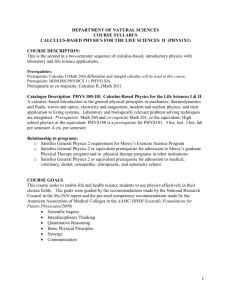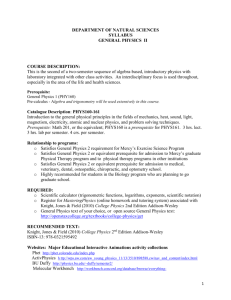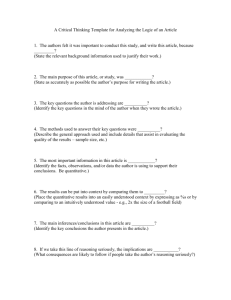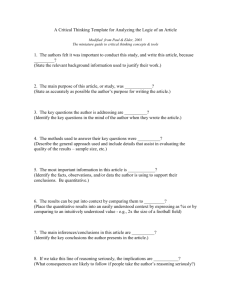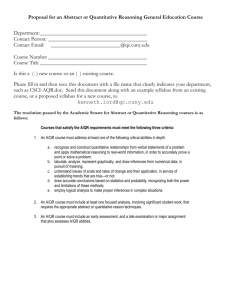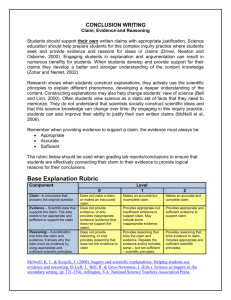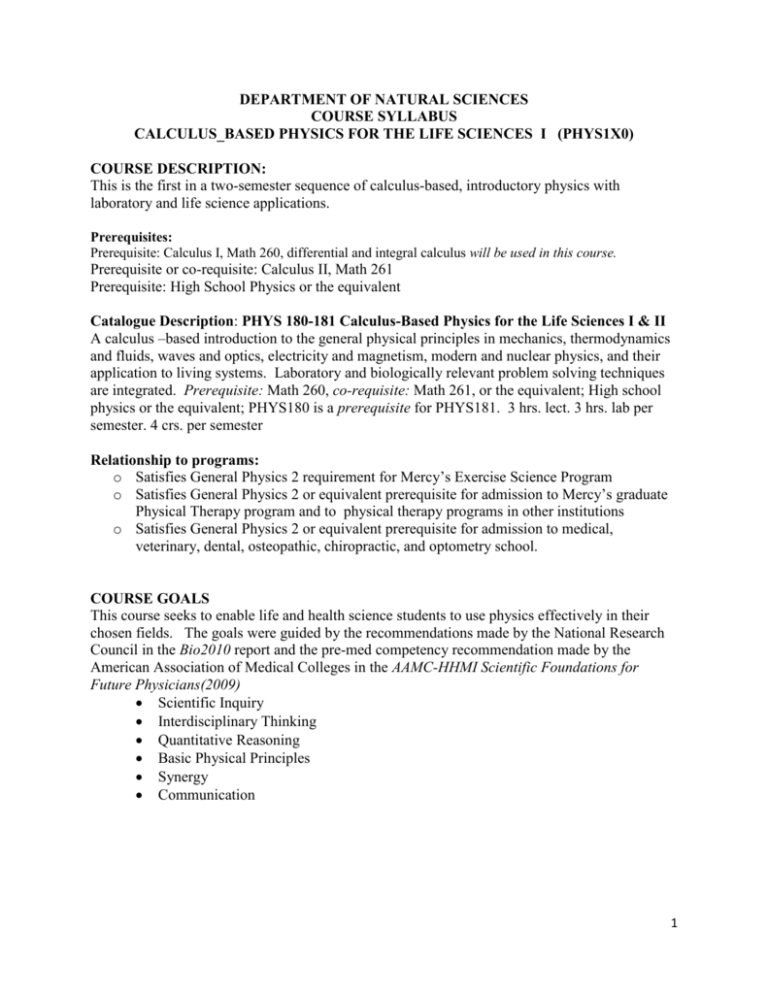
DEPARTMENT OF NATURAL SCIENCES
COURSE SYLLABUS
CALCULUS_BASED PHYSICS FOR THE LIFE SCIENCES I (PHYS1X0)
COURSE DESCRIPTION:
This is the first in a two-semester sequence of calculus-based, introductory physics with
laboratory and life science applications.
Prerequisites:
Prerequisite: Calculus I, Math 260, differential and integral calculus will be used in this course.
Prerequisite or co-requisite: Calculus II, Math 261
Prerequisite: High School Physics or the equivalent
Catalogue Description: PHYS 180-181 Calculus-Based Physics for the Life Sciences I & II
A calculus –based introduction to the general physical principles in mechanics, thermodynamics
and fluids, waves and optics, electricity and magnetism, modern and nuclear physics, and their
application to living systems. Laboratory and biologically relevant problem solving techniques
are integrated. Prerequisite: Math 260, co-requisite: Math 261, or the equivalent; High school
physics or the equivalent; PHYS180 is a prerequisite for PHYS181. 3 hrs. lect. 3 hrs. lab per
semester. 4 crs. per semester
Relationship to programs:
o Satisfies General Physics 2 requirement for Mercy’s Exercise Science Program
o Satisfies General Physics 2 or equivalent prerequisite for admission to Mercy’s graduate
Physical Therapy program and to physical therapy programs in other institutions
o Satisfies General Physics 2 or equivalent prerequisite for admission to medical,
veterinary, dental, osteopathic, chiropractic, and optometry school.
COURSE GOALS
This course seeks to enable life and health science students to use physics effectively in their
chosen fields. The goals were guided by the recommendations made by the National Research
Council in the Bio2010 report and the pre-med competency recommendation made by the
American Association of Medical Colleges in the AAMC-HHMI Scientific Foundations for
Future Physicians(2009)
Scientific Inquiry
Interdisciplinary Thinking
Quantitative Reasoning
Basic Physical Principles
Synergy
Communication
1
COURSE OBJECTIVES:
Scientific Inquiry
The student shall be able to:
Demonstrate creative inquiry into the physical basis of natural phenomena
Develop observational and interpretive skills through hands-on laboratory
Use measurements of physical phenomena to elucidate and validate scientific discovery
Use computer data acquisition and analysis for measurement of basic physical quantities
Quantitative Reasoning
The student shall be able to:
Facility with the kinds of functional relationships among physical quantities that are
prevalent in the natural world, with the natural use of calculus
Create and use mathematical models
Create and interpret visual displays of data
Basic Physical Principles
The student shall be able to:
Recognize basic physical principles in a variety of natural processes at different scales,
from the molecular to the organismal.
Apply foundational principles of change and interaction to the mechanisms of biological
processes in living systems.
Interdisciplinary Thinking and Synergy
The student shall be able to:
Make connections between biology and the physical sciences; interdisciplinary thinking
becoming second nature
Apply multiple physical principles to complex natural processes, as is typically manifest
in living systems.
Communication
The student shall be able to:
Be able to discuss physical phenomena using appropriate physics terminology
Be able to articulate reasoning in discussion of physical processes in nature
STUDENT LEARNING OUTCOMES:
Scientific Inquiry
The student shall be able to:
1. Demonstrate creative inquiry into the physical basis of natural phenomena
2. Demonstrate observational and interpretive skills
Hands-on activities in virtually every class
Bodies-on activities using kinesthetic sense
3. Operate basic laboratory instrumentation for scientific measurement or field experiences.
Computer-acquisition and analysis of data using:
2D Force Plates, Force sensors, Motion sensors, 3 D accelerometers, goniometers,
temperature sensors, pressure sensors, infrared sensors
Video analysis of visibly dynamic phenomena
2
4. Articulate reasoning to explain or question data.
5. Raise scientific questions and hypotheses, design experiments, acquire data, perform data
analysis, and present results.
Guided inquiry during class
Student projects
Quantitative Reasoning
The student shall be able to:
1. Express and analyze natural phenomena in quantitative terms that include an understanding
of the natural prevalence of basic functional relationships
Proportional and Linear relationships
Quadratic relationships
Inverse and inverse square relationships
Logarithmic/exponential relationships
Periodic relationships
2. Use of units of measurable quantities; dimensional analysis and unit conversion
3. Identify functional relationships from visually represented data
Interpret physical meaning of graphical representations of data
o Slope/Derivatives
o Area under curve/Integration
o Y-intercept/Limits of Integration
Describe graphical functional relationships in mathematical form
Draw and interpret visual display of vectors
o Motion Diagrams
o Free-body diagrams
o Extended body diagrams
4. Model functional relationships
Be able to mathematically model pertinent aspects of a natural phenomenon in terms
of functional relationships of measurable quantities
Make inferences about natural phenomena using mathematical models
Be able to articulate in words what relationships a mathematical model is expressing
Be able to discuss limitations of models, the simplifications and approximations
made, and the temporal and spatial scale in which it is relevant.
5. Quantify and interpret changes in dynamical systems
Kinematics, using calculus
Biomechanical dynamics
1D Linear dynamics
2D linear dynamics
Rotational dynamics
Thermodynamics
Fluid dynamics
3
Basic physical principles
The student shall be able to:
1. Apply principles of mechanics to living systems
• Apply the interrelationships among work, energy, force, and acceleration.
o How do you move objects
o How do you get moved by objects (as a passenger)
o How do you move yourself (locomotion)
• Apply the interrelationships among rotational work, rotational energy, torque, and
angular acceleration
o How engagement of your muscles moves your limbs
• Apply principles of mechanics to movement in biological systems at various scales,
from the molecular to the organismal.
o How your limbs enable you to move objects and move yourself
o How food energy is converted into muscular work
2. Apply principles of thermodynamics and fluid motion and the application to functional
properties of tissues and organisms. .
Heat transfer mechanisms and role of evaporation in the body
Entropy, life, and energy efficiency
Fluids and Pressures in the Body
Blood pressure and vascular blood flow
Lung pressures and breathing
Random Walks, Diffusion, and Osmosis
Effect of temperature on enzymes activity
Metabolic rate and caloric requirements
Synergy of principles in complex living systems
The student shall be able to:
1. Apply physical principles to the function of cells, tissues, organs, and organisms.
Apply physical principles to the functional properties of tissues and organs. Examples:
o Elasticity/Injury of Body Tissues
o Respiratory System
o Circulatory System
Apply physics principles to biomechanics and exercise Examples:
o Food energy conversion into muscular work
o Gait analysis
o Biomechanics to optimize sports technique
o Exercise equipment design for optimal muscular engagement
o Ergonomic considerations in human movement
2. Apply physical principles to the mechanisms by which organisms sense and control their
internal environment, sense and respond to their external environment. Examples:
Energy in bodily processes
Thermal regulation of the body
Vestibular apparatus - Balance
Cutaneous receptors and proprioceptors
4
3. Apply physical principles to the possible mechanisms of occupational and physical therapy
modalities Examples:
o Exercise equipment mechanics
o Traction
o Therapeutic heat and cold
o Aquatics and hydrotherapy
4. Apply physics principles to biomedical and biophysics research techniques Example:
Centrifuge
5. Apply physics principles to health field specializations
o Dental Example:
o Chewing mechanics, TMJ
o Tooth damage and repair
o Veterinary Examples:
o Distinctive animal locomotion and physiology
o Extreme environment coping mechanisms
6. Apply physics principles to living on the earth, in the modern world Examples:
o Climate effects, atmosphere, global warming, hurricanes, tornados
o Shelter/clothes and temperature regulation
o Transportation mechanics
o Moving walkways, elevators
o Surface vehicles
o Air and water transport
METHODS USED TO ASSESS STUDENT LEARNING OUTCOMES
Suggested
Exams/Quizzes: (10%-60%)
Projects: (10%-40%)
Homework: (10%-25% )
Class/Lab Activities: (20%-25%)
COURSE ACTIVITIES
Individual Practice
Homework Questions
o Approximately 10 conceptual questions per week, or the equivalent
o Approximately 10 problems requiring quantitative analysis per week, or the
equivalent
Project
o A self-directed, self-chosen, semester-long project integrating many concepts,
submitted online at interim points.
5
Online
o Viewing and discussion of each other’s projects
o Interactive Simulations/Animations (1-5 each week)
o Informative Websites
Required Classroom Participation
This course is taught in a “workshop” style where a learner-centered classroom is integrated with
laboratory activities. Every class will include lab, computer, and collaborative learning
activities.
Lab Activities
o In class hands-on exploration and inquiry
o In class data acquisition, taken and discussed collaboratively
o Quantitative analysis of data in or out of class
Computer Activities
o Interactive Simulations/Animations
o Computerized data acquisition and analysis
o Video-analysis
Collaborative Learning
o Whiteboard display of group work
o Group discussion and prediction
o Group inquiry and discussion
COURSE COMPETENCIES: At Mercy College, we want to ensure that the student will be
able to effectively compete for jobs and careers in an increasingly complex world. Therefore, the
College has focused on six foundational skills that we feel will help students achieve greater
success in college as well as in their career. The student will be expected to meet minimum
levels of achievement for graduation in these six competencies:
Primary
Critical Thinking: Students’ critical thinking skills are necessary for successful completion of
this course. They will have to apply foundational ideas to a variety of natural phenomena,
including in their self-directed projects. They will have to analyze data qualitatively and
undertake a process of inquiry encouraged by the active classroom activities.
Quantitative Reasoning: Quantitative reasoning is required for successful completion of this
course. Students are required to use mathematical models of functional relationships of
measurable quantities, to analyze data quantitatively, and be able to interpret visual displays of
quantitative data.
Secondary
Critical Reading: Students’ critical reading skills will be measured by their ability to critically
review and evaluate online resources of information and other students’ written work.
Information Literacy: Students will research physics topics of their own choosing.
Tertiary
Written Communication: Students’ writing skills will be measured by their ability to articulate
their understanding in writing on exams, in project presentations, and/or in online discussions.
Oral Communication: Students’ oral communication skills will be measured by the quality of
their engagement in class discussion and collaborative group work, especially during lab
6
activities. Students will be expected to orally articulate their reasoning for their predictions and
interpretations of data.
REQUIRED TEXT:
Physics for the Life Sciences, Timothy McKay, San Francisco, Pearson Addison Wesley, to be
published by Fall 2013
Required: Calculator (scientific- trigonometric functions, exponentials, logs, etc.)
COURSE POLICIES
1. Attendance Policy – It is assumed that a student will attend all classes for which he/she is
registered. Ceasing to attend classes for three consecutive class meetings without contacting
the instructor will result in the issuance of a grade of “FW” which indicates “stopped
attending.” This grade of “FW” will be calculated into the student’s GPA as an “F” and may
result in dismissal. In addition this status will be reported to The Office of Student Services
and may result in a reduction of financial aid monies.
Because this course is participatory in nature and has integrated lab and group activities,
attendance is necessary to do well in the course. Expect lack of attendance or frequent
lateness to be reflected in the course grade.
2. Cheating and Plagiarism – Cheating and plagiarism are contrary to the purpose of any
educational institution and must be dealt with most severely if students’ work is to have any
validity. An instructor who determines that a student has cheated on a test or assignment will
at a minimum give a zero for that item and may give a failure for the course. Normally the
matter is handled between the instructor and the student, but either party to ensure fairness
may consult the department chairperson. Suspicion of cheating on exams (e.g. as when two
students sitting next to each other have unnaturally similar answers) will result in another
exam taken in place of the original by all parties involved.
Plagiarism, which is the appropriation of words or ideas of another without
recognition of the source, is another form of cheating. An instructor who determines that a
student has plagiarized will give a zero for the homework or project and may give a failure for
the course.
Both cheating and plagiarism are grounds for dismissal from the College. Any action
taken regarding cheating or plagiarism is subject to the Academic Grievance Policy outlined
above and in the Student Handbook.
3. Cell Phone Use – Cell phones should be turned off prior to the start of class. Students who do
not abide by this policy may be asked to leave for the day and will receive an unexcused
absence.
Resources
Science Learning Center - in Dobbs Ferry Learning Center
Free Physics Tutoring - Hours to be announced
For Tutoring needs, email: tutoring@mercy.edu
7
Websites: Major Educational Interactive Animations activity collections
PhET http://phet.colorado.edu/index.php
ActivPhysics h ttp://wps.aw.com/aw_young_physics_11/13/3510/898588.cw/nav_and_content/index.html
BU Duffy http://physics.bu.edu/~duffy/semester1/
Molecular Workbench http://workbench.concord.org/database/browse/everything-list/
Physics Tutorial Collections
Physics Classroom Multimedia Physics Studio http://www.physicsclassroom.com/mmedia/index.cfm
Hyperphysics http://hyperphysics.phy-astr.gsu.edu/hbase/hframe.html
KhanAcademy http://www.khanacademy.org
BIBLIOGRAPHY
Keston & Tauck, (2012) University Physics for the Physical and Life Sciences, Freeman
Knight, Randall (2012). Physics for Scientists and Engineers 3nd edition, Addison-Wesley
Newman, Jay (2008) Physics of the Life Sciences Springer
Tuszynski ( 2001). Biomedical Applications of Physics, Wiley
Hewitt, Paul (2010). Conceptual Physics, 11th edition, Addison-Wesley
Cameron, Skofronick, Grant (1999). Physics of the Body, Medical Physics Publishing
Urone, Peter (2001). College Physics, 2nd Edition, Brooks Cole
Urone, Peter (1986). Physics with Health Science Applications, Wiley
Hobbie, R. (1997). Intermediate Physics for Medicine and Biolog,y 3rd edition, Springer
Wisneski, L. (2009). The Scientific Basis of Integrative Medicine, CRC Press
George B. Benedek and Felix M.H. Villars (2000) Physics with Illustrative Examples from
Medicine and Biology, volumes 1, 2, and 3, AIP Press
Morton M. Sternheim, Joseph W. Kane (1991) General Physics, 2nd Edition, J. Wiley & Sons
8

